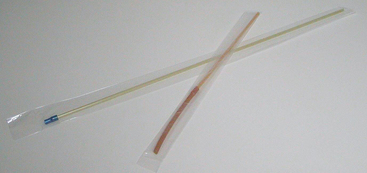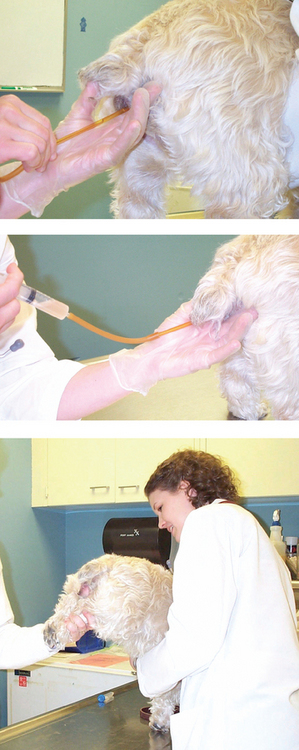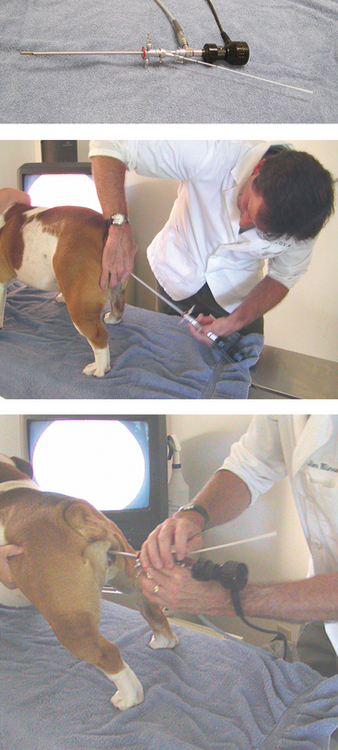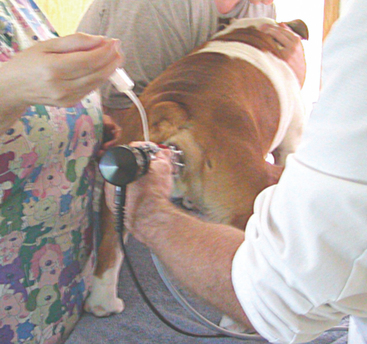21 Artificial Insemination
In general, the more the spermatozoa are manipulated, the worse the conception rate. Natural service is best, with fresh semen a close second, followed by chilled semen, then frozen semen. Conception rate can be improved by good timing of insemination, inseminating more than once whenever possible, and inseminating in the proper location.
I. TYPES OF INSEMINATION
A. VAGINAL
Semen is placed within the bitch’s vagina using a pipette. I prefer long bovine pipettes to the short canine pipettes that are marketed for AI in dogs (Figure 21-1). A specific insemination pipette for dogs, the Osiris pipette, also is available. This pipette contains a balloon that is inflated to prevent backflow of semen.
The gloved index finger of the nondominant hand is inserted into the vaginal vault; this may not be possible in very small dogs. This finger prevents movement of the insemination pipette into the urinary bladder. The hand is turned so that the palm of the hand is turned up. The semen is drawn into a syringe and connected to the pipette. The pipette is passed over the inserted index finger as far into the vagina as it will pass without causing discomfort to the bitch (Figure 21-2). The pipette is withdrawn slightly to ensure that it is not trapped against the vaginal wall and the semen expressed through the pipette with the syringe. A small amount of air also is introduced to ensure that all the semen has been introduced into the vagina. The pipette is removed, and the gloved finger is used to stroke the ceiling of the vagina. This often stimulates vaginal contraction and may help move spermatozoa forward in the reproductive tract.
During and after insemination, it is important that no pressure be placed upward on the dog’s caudal abdomen. The vagina lies in the horizontal plane in the caudal abdomen and is muscular. Any upward pressure will cause expulsion of the semen introduced. After insemination, the bitch may be “wheelbarrowed” up onto her forelimbs for 5 to 20 minutes to promote semen pooling at the cervix. Holding the bitch up in this fashion is not necessary to achieve good conception rates, however. Similarly, many people recommend that dogs not be allowed to squat to urinate or to jump up into a car or onto furniture for 20 to 30 minutes after insemination; again, this has not been shown to be necessary.
B. INTRAUTERINE
2. Endoscopic
This is not a blind technique. The bitch need not be sedated in most cases. The bitch is restrained standing. A long, narrow endoscope is passed the length of the vagina and used to visualize the cervix (Figure 21-3). A urinary catheter is passed through a channel on the endoscope, which is used to guide the catheter through the cervix. Semen is expressed through the catheter with a syringe. Because this technique is noninvasive, multiple inseminations can be performed during a given estrus. This technique requires specialized equipment and is technically demanding. The cervix hangs from the ceiling of the vagina and is muscular. The opening of the cervix lies perpendicular to that of the vagina, requiring deflection of the catheter as it enters the cervix. Often multiple attempts are required before the catheter passes, and in some bitches the catheter cannot be passed using this technique. Endoscopic insemination is available throughout the United States.
< div class='tao-gold-member'>
Stay updated, free articles. Join our Telegram channel

Full access? Get Clinical Tree






